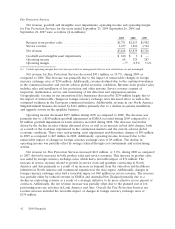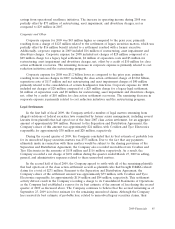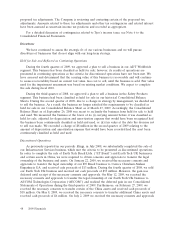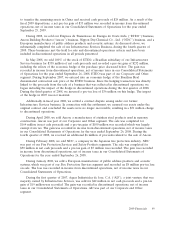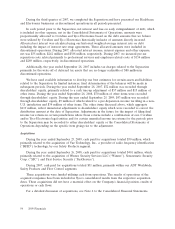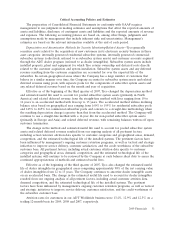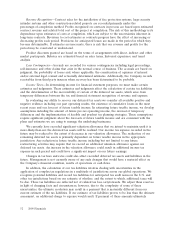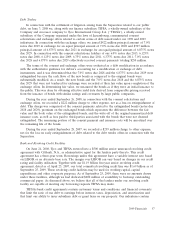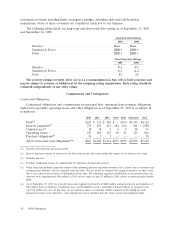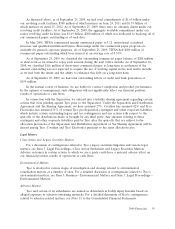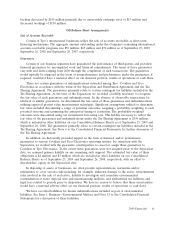ADT 2009 Annual Report Download - page 144
Download and view the complete annual report
Please find page 144 of the 2009 ADT annual report below. You can navigate through the pages in the report by either clicking on the pages listed below, or by using the keyword search tool below to find specific information within the annual report.Revenue Recognition—Contract sales for the installation of fire protection systems, large security
intruder systems and other construction-related projects are recorded primarily under the
percentage-of-completion method. Profits recognized on contracts in process are based upon estimated
contract revenue and related total cost of the project at completion. The risk of this methodology is its
dependence upon estimates of costs at completion, which are subject to the uncertainties inherent in
long-term contracts. Revisions to cost estimates as contracts progress have the effect of increasing or
decreasing profits each period. Provisions for anticipated losses are made in the period in which they
become determinable. If estimates are inaccurate, there is risk that our revenue and profits for the
period may be overstated or understated.
Product discounts granted are based on the terms of arrangements with direct, indirect and other
market participants. Rebates are estimated based on sales terms, historical experience and trend
analysis.
Loss Contingencies—Accruals are recorded for various contingencies including legal proceedings,
self-insurance and other claims that arise in the normal course of business. The accruals are based on
judgment, the probability of losses and, where applicable, the consideration of opinions of internal
and/or external legal counsel and actuarially determined estimates. Additionally, the Company records
receivables from third party insurers when recovery has been determined to be probable.
Income Taxes—In determining income for financial statement purposes, we must make certain
estimates and judgments. These estimates and judgments affect the calculation of certain tax liabilities
and the determination of the recoverability of certain of the deferred tax assets, which arise from
temporary differences between the tax and financial statement recognition of revenue and expense.
In evaluating our ability to recover our deferred tax assets we consider all available positive and
negative evidence including our past operating results, the existence of cumulative losses in the most
recent years and our forecast of future taxable income. In estimating future taxable income, we develop
assumptions including the amount of future pre-tax operating income, the reversal of temporary
differences and the implementation of feasible and prudent tax planning strategies. These assumptions
require significant judgment about the forecasts of future taxable income and are consistent with the
plans and estimates we are using to manage the underlying businesses.
We currently have recorded significant valuation allowances that we intend to maintain until it is
more-likely-than-not the deferred tax assets will be realized. Our income tax expense recorded in the
future may be reduced to the extent of decreases in our valuation allowances. The realization of our
remaining deferred tax assets is primarily dependent on future taxable income in the appropriate
jurisdiction. Any reduction in future taxable income including but not limited to any future
restructuring activities may require that we record an additional valuation allowance against our
deferred tax assets. An increase in the valuation allowance could result in additional income tax
expense in such period and could have a significant impact on our future earnings.
Changes in tax laws and rates could also affect recorded deferred tax assets and liabilities in the
future. Management is not currently aware of any such changes that would have a material effect on
the Company’s financial condition, results of operations or cash flows.
In addition, the calculation of our tax liabilities involves dealing with uncertainties in the
application of complex tax regulations in a multitude of jurisdictions across our global operations. We
recognize potential liabilities and record tax liabilities for anticipated tax audit issues in the U.S. and
other tax jurisdictions based on our estimate of whether, and the extent to which, additional taxes will
be due. These tax liabilities are reflected net of related tax loss carryforwards. We adjust these reserves
in light of changing facts and circumstances; however, due to the complexity of some of these
uncertainties, the ultimate resolution may result in a payment that is materially different from our
current estimate of the tax liabilities. If our estimate of tax liabilities proves to be less than the ultimate
assessment, an additional charge to expense would result. If payment of these amounts ultimately
52 2009 Financials


